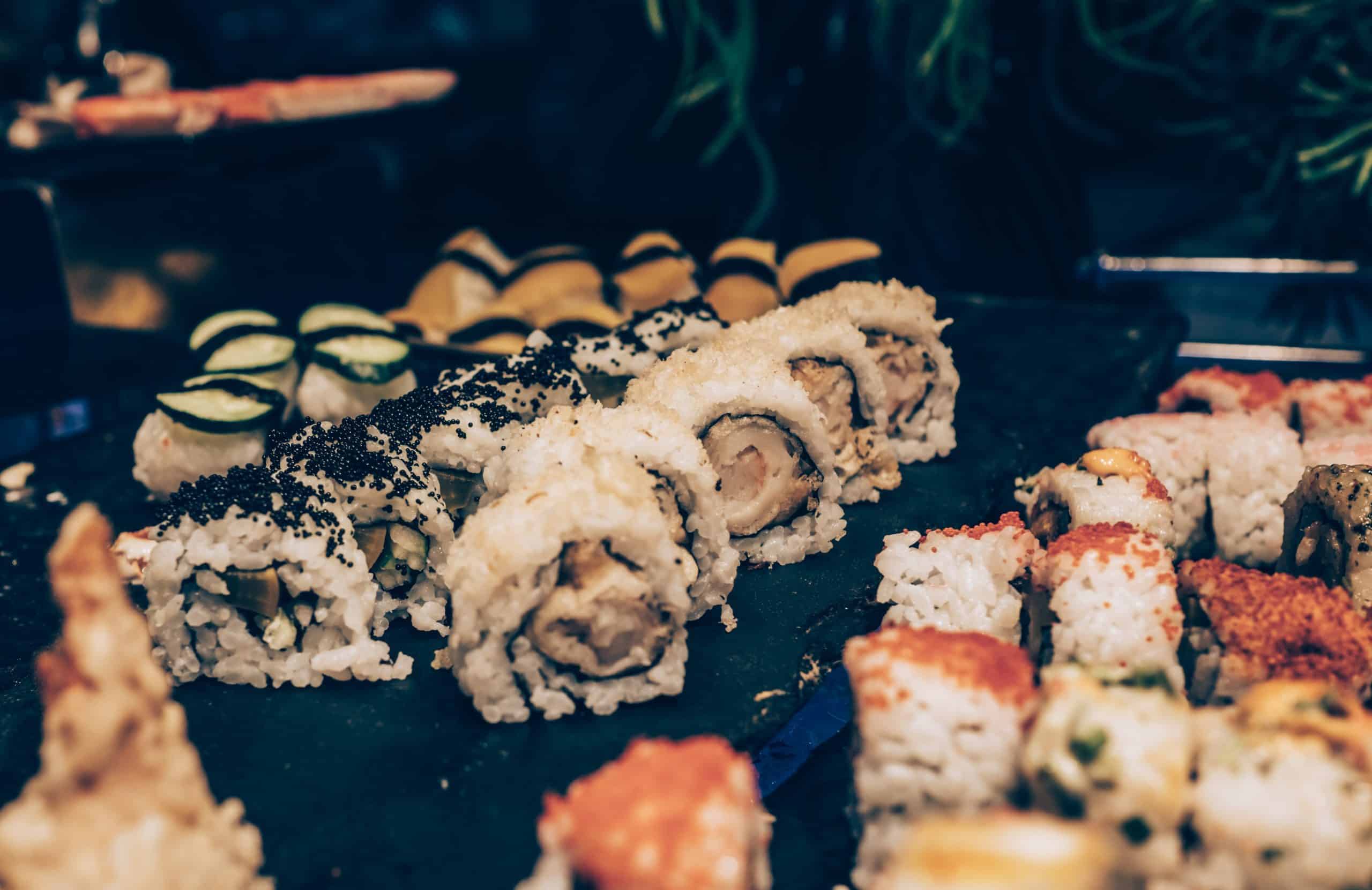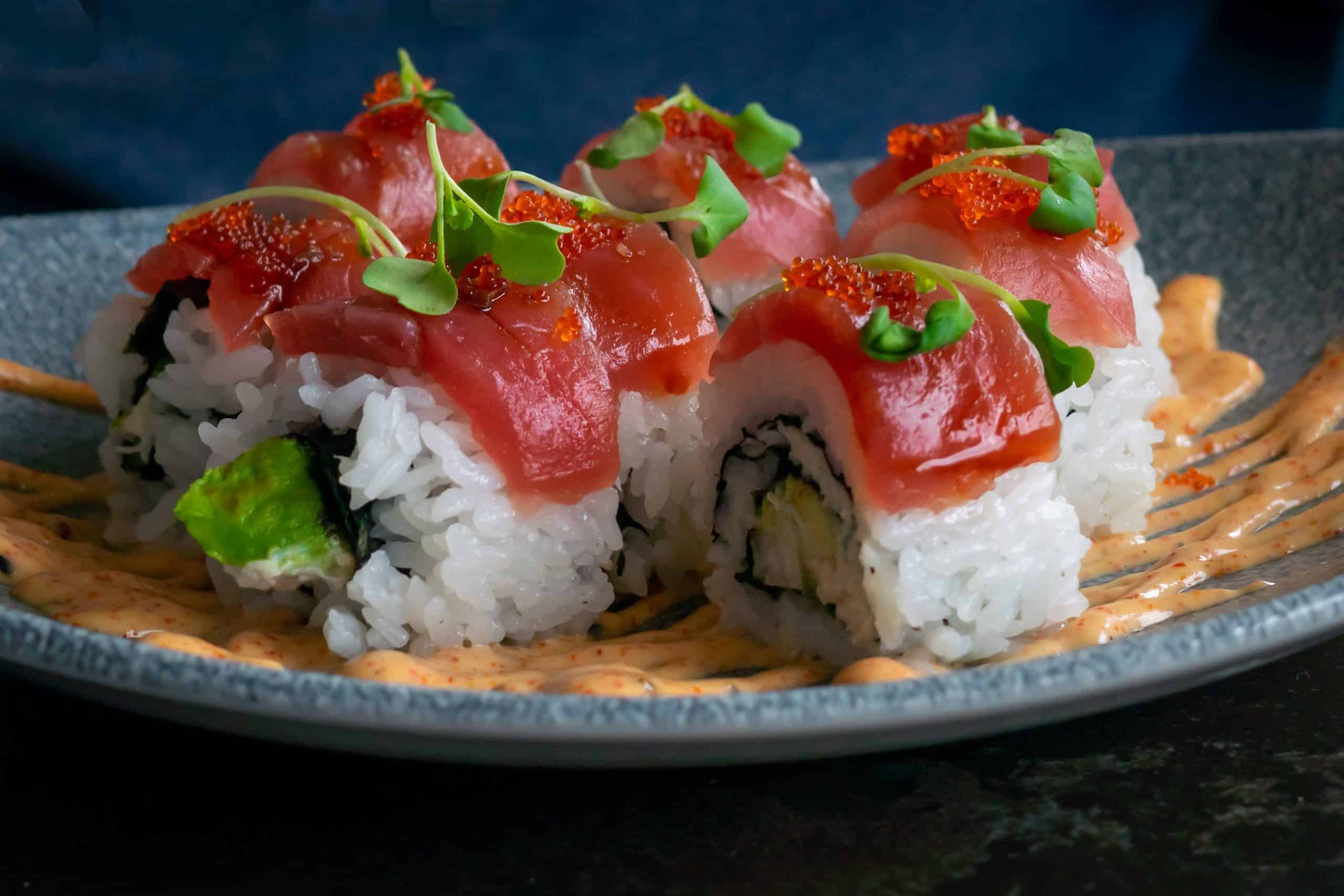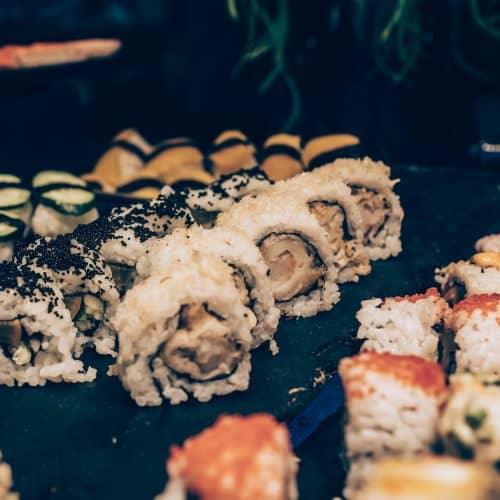Sushi vs. maki: What are the differences? What does sushi mean anyway?
Have you ever tried sushi? What about maki?
A lot of people ask: are maki and sushi the same? When it comes to sushi vs. maki, what are the differences exactly?
If you’ve ever seen sushi on the menu as well as maki, know that maki is just one of the types of sushi that you can order. Maki is fish or vegetable with rice rolled in nori (seaweed). But there are other types of sushi besides maki.

Read all about the different kinds of sushi in our in-depth post here
The recipe for sushi requires the use of vinegar rice for preparation, with added ingredients (i.e., salt and sugar).
The meal usually accompanies plenty of other ingredients, like vegetables and seafood. Even tropical fruits are used occasionally in sushi!
Garnishes are extensive with sushi, and the flavor’s enhanced with the use of vinegar.

Check out our new cookbook
Bitemybun's family recipes with complete meal planner and recipe guide.
Try it out for free with Kindle Unlimited:
Read for freeIn this post we'll cover:
Sushi vs. maki
This Japanese dish, sushi, is made out of rice and is often confused with maki. If you think sushi is maki, then you should know that maki is actually a variant or a kind of sushi.
Basically, maki is the name for sushi rolls, which you most commonly find in the West. Another common name for it is rolled sushi.
Typically, when someone wants to try Japanese cuisine, sushi is at the top of the list. The variety of sushi dishes is endless.
Sushi (especially sushi rolls) are famous all around the world. I think the most common image that comes to mind when you think of “maki” is the California roll, although maki is most often used to describe the small and simple sushi rolls with nori on the outside.
The California roll is a sushi roll filled with imitation crab meat called surimi, plus cucumber and avocado. It’s most popular in America and Western Europe, but it isn’t actually Japanese.
Learn all about the differences between American and Japanese sushi in our post here
Well, let me clear up the old sushi versus maki conflict. As stated earlier, sushi is the main rice dish of Japan. Maki, on the other hand, is a sushi type: rolled sushi.
The former comes garnished with ingredients like seafood, vegetables, and vinegar flavor.
Another exciting presentation of sushi is as a roll inside nori, which happens to be a compressed well-dried sheet of seaweed.
Brief history of sushi maki
The famous sushi dish of today was initially presented in Tokyo, which was known as Edo at that time. The man behind this fantastic yet delicious creation is Hanaya Yohei.
Soon after the development, it was named Edomae zushi. This was in honor of the fish the dish was made from.
Read more: Hanaya Yohei’s rebel history
This very fish used in the recipe was taken from Edomae, which is now known as Tokyo Bay.
Maki sushi appeared around the time that nori (or seaweed sheets) were invented in the 1750s. Since nori was easy to use, people started to experiment.
The first rolled sushi was invented and it was a mix of rice and other seasoned ingredients.
The word “makizushi” first appears in 1749 in a book called Ryōri Sankaikyō (料理山海郷).
However, it didn’t refer to the same maki dish we’re familiar with these days. It was the term for seafood rolled with the aid of a bamboo mat.
But the concept is still similar to modern maki!
Who invented maki?
As you’ve just read, a variant of maki was invented many centuries ago.
The gunkan maki (a special type of maki) was invented in 1941 at the Ginza Kyubey restaurant. They began to serve rolled sushi with a large variety of ingredients and toppings. It really made the maki popular all over Japan!
What is “maki” in Japanese?
Maki is the Japanese word for “roll”. That’s why “sushi maki” is translated into “sushi roll”. “Maki” is an abbreviation of the word “makizushi”.
Is maki raw fish?
There’s a common misconception that maki is a raw fish dish, but that’s not necessarily true.
Maki rolls can contain raw fish as their ingredient. However, “maki” isn’t a term for raw fish. You can find sushi maki with all kinds of fillings, including raw fish, other seafood, meats, and vegetables.
If you think of maki as raw fish, then you’re mistaking it for sashimi, a raw fish dish. It’s served without rice and contains raw slices of fish, especially tuna or salmon.
How do you eat maki?
There are 2 ways to eat Maki sushi.
The first: Use chopsticks to grab one roll at a time. You can dip the roll in soy sauce then eat it.
The second: Use your hands and grab a roll. Place it between your thumb and middle finger, and lift it to your mouth.
What is in sushi and how is it prepared?
Sushi is known as a rice-based dish; the main ingredient is sticky rice. Sushi rice has a unique appearance that’s short and sticky, as seen with Japanese grain.
The complementary components can be fish, chicken, pork, seafood, and vegetables. These can serve both as a topping or a filler.
The flavor may be enhanced with condiments, soy sauce, and rice vinegar.
Sushi has gained popularity all around the globe. The most common sushi rolls are the dragon roll and the California roll in the West.
Technically, it has 2 main parts: One is shari and the other is neta.
The 2 components of sushi are:
- The cooked rice with vinegar (shari)
- All other ingredients that complete the dish (neta)
- The word “sushi” literally means “sour taste” and goes well with the vinegar and fermented fish used for preparing it.
What are the 3 types of sushi?
Most people are familiar with the 3 types of sushi because they’re popular worldwide:
- Maki – The rolled-up sushi wrapped in nori (seaweed)
- Nigiri – Sliced raw fish on top of a ball of rice
- Sashimi – Sliced raw fish served on its own without rice
Then what’s in maki?

Other types of maki sushi:
Maki follows exactly the same recipe as sushi. But then why do we have a different name for it?
Also read: here are the best sushi kits reviewed
So here lies the answer: maki comes in a wrapping that’s sushi presented in nori.
Are there any variants of maki?
Yes, there are various kinds and subdivisions of maki, just like with sushi.
Maki has different names, depending on the size of the roll. Some of them are listed below:
- Futomaki: largest rolls
- Nakamaki: medium-sized rolls
- Hosamaki: small rolls
- Temaki: a hand-rolled maki
- Uramaki: an inside-out roll presentation of maki
What are the other types of maki and sushi?
So the case with sushi is that there are several types. These are catered and presented all over the globe.
They also come with a unique flavor, name, and presentation, making it a different class altogether:
- oshizushi: Also called pressed sushi, oshizushi comes in the shape of a square. The wooden frame pushes all ingredients into a perfect square.
- Chirashizushi: This is a bowl of vinegar rice (shari) that comes with fish on top. The fish is served raw and can be into slices and thin pieces. It’s also known as sprinkled sushi.
- Nigirizushi: This is served as a mound of rice overlaid with wasabi and tuna, salmon fish, etc., and is presented with a thin wrapping of nori.
- Inarizushi: This is shari that comes packed in a pocket of tofu and is deep-fried.
- Makizushi: The fish and added ingredients are twisted into shari and nori with the use of bamboo mats, and cut into pieces for its final presentation.
- Narezushi: This is a traditional representation of sushi. There’s rice, in combination with fish that’s been reeled and skinned for a 6-month fermentation with salt.
- Gunkan maki: This is another type of maki or rolled sushi. It resembles a small battleship. The nori sheet is wrapped around a ball of rice and there’s enough space to fill it. The top is filled with all kinds of ingredients, such as uni (sea urchin), squid, and salmon.
Also read: sushi for beginners, a complete guide
Sushi maki recipe: California Roll
The California roll is an American invention or take on sushi rolls. It’s one of the most popular menu items at sushi restaurants across the Western world.
It’s not difficult to make, so you can actually make it at home! Here’s the recipe.

Sushi maki California roll
Ingredients
For the Sushi Rice
- 1 ⅓ cup sushi rice
- 1½ cups water
- 2 tbsp rice vinegar
- 1 tbsp sugar
- 1½ tsp salt
For the filling
- 8 ounces imitation crab meat sticks
- 3 sheets nori seaweed sheets
- ½ English cucumber
- 1 avocado
- 1½ tsp sesame seeds toasted
Instructions
- Rinse and cook the sushi rice for 15 minutes on low heat. Let it sit for 15 minutes if not cooked in a rice cooker.
- In a bowl, microwave the salt, sugar, and vinegar for short 15-second bursts twice until all solids are melted.
- Cut the nori sheets in half. Unwrap the crab meat.
- Cut the cucumber into thin sticks about 1/3 inches wide.
- Peel and cut the avocado into thin sticks 1/3 inches wide like the cucumber.
- Place the rice into a large bowl and mix in the vinegar mixture.
- Dampen hands with water. Place the nori sheet on a bamboo mat. Place the sheet with the long side lined up with the mat's bottom.
- Put 1/6th of the rice onto the nori and press to even out the rice to the edges of the sheet.
- Sprinkle the rice with a small amount of sesame seeds.
- Add the rest of your filling ingredients to the sheet. Add only a small portion on each sheet to avoid overstuffing.
- Fold the top half of the mat over and press to make the rice compact.
- Fold the bottom part as well, until the top and bottom are touching. The mat should completely wrap your roll.
- Now start rolling the sushi roll away from you. The roll should be completely round.
- Take off the bamboo mat and cut up your roll into 6 pieces with a damp cool knife. Then cut each roll in half crosswise.
- Serve sushi within an hour for freshness.
Also read: learn how to make the perfect sushi sauce with one of our recipes
Check out our new cookbook
Bitemybun's family recipes with complete meal planner and recipe guide.
Try it out for free with Kindle Unlimited:
Read for freeJoost Nusselder, the founder of Bite My Bun is a content marketer, dad and loves trying out new food with Japanese food at the heart of his passion, and together with his team he's been creating in-depth blog articles since 2016 to help loyal readers with recipes and cooking tips.
